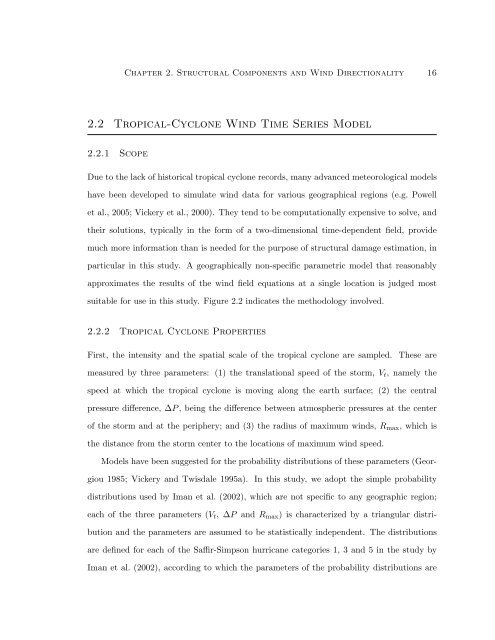Wind Hazard Risk Assessment and Management for Structures
Wind Hazard Risk Assessment and Management for Structures
Wind Hazard Risk Assessment and Management for Structures
Create successful ePaper yourself
Turn your PDF publications into a flip-book with our unique Google optimized e-Paper software.
Chapter 2. Structural Components <strong>and</strong> <strong>Wind</strong> Directionality 16<br />
2.2 Tropical-Cyclone <strong>Wind</strong> Time Series Model<br />
2.2.1 Scope<br />
Due to the lack of historical tropical cyclone records, many advanced meteorological models<br />
have been developed to simulate wind data <strong>for</strong> various geographical regions (e.g. Powell<br />
et al., 2005; Vickery et al., 2000). They tend to be computationally expensive to solve, <strong>and</strong><br />
their solutions, typically in the <strong>for</strong>m of a two-dimensional time-dependent field, provide<br />
much more in<strong>for</strong>mation than is needed <strong>for</strong> the purpose of structural damage estimation, in<br />
particular in this study. A geographically non-specific parametric model that reasonably<br />
approximates the results of the wind field equations at a single location is judged most<br />
suitable <strong>for</strong> use in this study. Figure 2.2 indicates the methodology involved.<br />
2.2.2 Tropical Cyclone Properties<br />
First, the intensity <strong>and</strong> the spatial scale of the tropical cyclone are sampled. These are<br />
measured by three parameters: (1) the translational speed of the storm, Vt, namely the<br />
speed at which the tropical cyclone is moving along the earth surface; (2) the central<br />
pressure difference, ∆P , being the difference between atmospheric pressures at the center<br />
of the storm <strong>and</strong> at the periphery; <strong>and</strong> (3) the radius of maximum winds, Rmax, which is<br />
the distance from the storm center to the locations of maximum wind speed.<br />
Models have been suggested <strong>for</strong> the probability distributions of these parameters (Geor-<br />
giou 1985; Vickery <strong>and</strong> Twisdale 1995a). In this study, we adopt the simple probability<br />
distributions used by Iman et al. (2002), which are not specific to any geographic region;<br />
each of the three parameters (Vt, ∆P <strong>and</strong> Rmax) is characterized by a triangular distri-<br />
bution <strong>and</strong> the parameters are assumed to be statistically independent. The distributions<br />
are defined <strong>for</strong> each of the Saffir-Simpson hurricane categories 1, 3 <strong>and</strong> 5 in the study by<br />
Iman et al. (2002), according to which the parameters of the probability distributions are
















